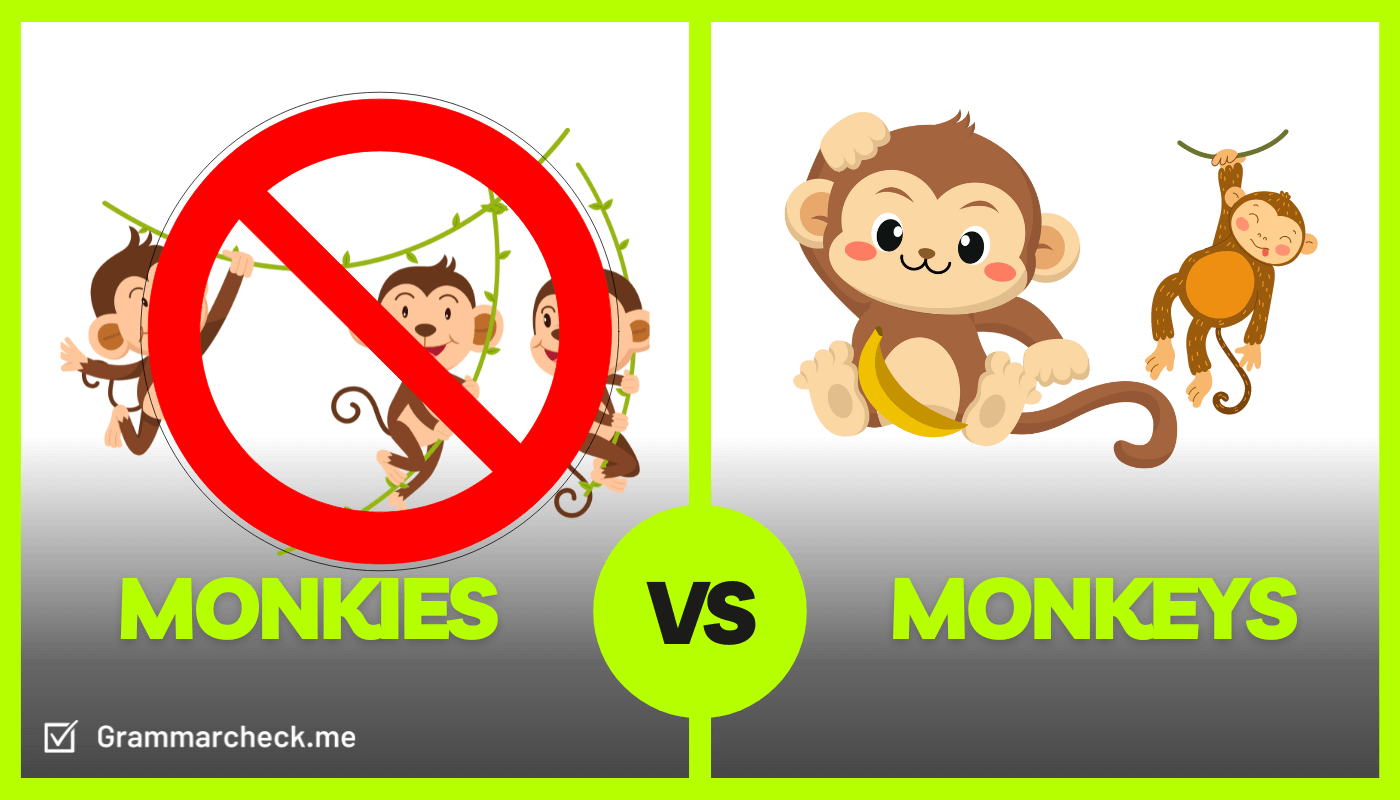Not sure whether the spelling is “monkies” or “monkeys?” Find out in this article.
English is a language notably less consistent than other languages. The grammar and spelling rules seem to vary so much that it’s hard to see them as rules.
One of the rules that’s confusing to English learners is changing words from singular to plural. Sometimes, this is as simple as adding an “s” to the end of the word, while other times, the plural is an entirely new word.
The word “monkey” is one word that has very different spellings in singular and plural states. Whether you’re talking about spider monkeys, marmosets, or chimpanzees, what exactly is the correct spelling of the plural of “monkey” – “monkies” or “monkeys”? Keep reading to find out.
Monkies or Monkeys – Which One to Use

When spelling out “monkies” or “monkey,” there is only one correct answer. To describe more than one monkey of any monkey species, you should spell it “monkeys.” It is no secret that vocabulary and grammar rules like this can bet tricky.
To illustrate, here are examples of each version of the word used in a sentence:
- There’s a monkey in that tree.
- We saw so many different monkeys at the zoo today!
This may be a confusing rule, as many words that end with a “-y” tend to end with “-ies,” and it may not even look right to see “ys” at the end of the word.
However, the truth is that there are two options when it comes to converting singular words that end in “-y” into their plural form – either replace the word with “ies,” or tack a simple “s” to the end of the word.
It can be hard to figure out when to use each, but there are a few rules and patterns that we’ll look at later that may be able to help you.
Finding out that “monkeys” is spelled with an “s” instead of an “ies” may have you confused about when to use either option in the plural form of a noun. To clear things up, let’s figure out when to use “ies.”
When to Use “-ies”
Pluralization is one of the most irregular aspects of the English language, and words that end in “y” are the perfect example of why. Take the comparison of the phrases Time Flys & Time Flies for example.
Some words that end in “y” need an “s” tacked on at the end to become plural. For others, a longer combination of “ies” is required to completely replace the last couple of letters at the end of a sentence. So why is “ies” used at all, and why can’t we just simply add “-s” to the end of every word to make it plural?
The main reason for this variation is aesthetic purposes. Certain words that end in “y” look strange when you simply tackle an “s” at the end.
Take the word “lady,” for example. The word “ladys” doesn’t look right, and most English speakers would not assume that the word was pronounced as it actually is, as “ladeez.” Instead, some might think of the pronunciation as being “ladis.” In contrast, “ladies” has a less ambiguous pronunciation based on the already established rules of the language.
Therefore, “ies” aligns with the standard norms in English language spelling and speech and maintains aesthetics in spelling.
Let’s look at a few examples of plural words that end in “-ies.”
Words that end in “-ies”
- Fly = flies (both the verb and the noun)
- Community = communities
- Beauty = beauties
- Baby = babies
- Story = stories
Let’s look at when to simply add an “s” to the end of a word. Read our post about the words lense vs lens to learn even more about creating plural nouns.
When to Use “s”
As a general rule, most nouns become plural by simply adding an “s” to the end. Take the words Parents’ or Parent’s for example. Any word that does not subscribe to this rule is an irregular plural noun. While we see that this is far from the most concrete rule, it should be the first one you consider when turning a singular noun into its plural form.
As we see, this isn’t the case with all words that end in “y.” However, there’s a way to figure out whether a word that ends with a “y” should end with an “-ies” or a simple “s.”
Here’s a pro tip to help you out: for most words that end in “-ey,” you simply need to add an “s” to make them plural. In fact, this is the case with “monkies” or “monkey.”
That said, sometimes the “s” is not enough. For example, for words that already end in “-s” in their singular form, you’ll need to add “es” instead of another “s.” The same goes for words that end in “sh,” “ch,” “x,” or “z.”
Here are a few examples of such words:
- Bus = buses
- Dress – dresses
- Couch = couches
- Brush – brushes
- Tax = taxes
Words that end in “ys”
Here are some words, like “monkeys,” that end in “-ys”:
- Key = keys
- Journey = journeys
- Trolley = trolleys
- Chimney = chimneys
There aren’t an overwhelming number of words that follow this rule, but it’s still a substantial number that requires you to remember this rule and understand how to use it. Words that end in -y like Nosey and Nosy follow a similar rule!
Exceptions to the Plural Rules
Finally, a few irregular plural nouns don’t subscribe to any of the rules outlined so far. Just like we saw with the words Nana and Nanna, there are always exceptions to spelling & grammar rules!
Words that end in “f” have their own set of rules. The “f” is typically replaced with a “ve.” Here are a few examples:
- Elf = elves
- Calf = calves
- Knife = knives
In addition, there are some words that, when they become plural, don’t end with an “s” at all. Instead, their words undergo a vowel change in the middle of the word. Some examples include:
- Mouse = mice
- Man = men
- Goose – geese
- Tooth = teeth
What’s more, some words are the same in plural as they are in the singular, such as:
- Salmon
- Sheep
- Deer
- Fish
- Species
Wrap Up
The correct spelling between “monkies” and “monkeys” is the latter, whether you’re talking about a spider monkey, howler monkey, or capuchin monkey. This is based on a general rule for turning words that end in “ey” into the plural form, where you simply tack on an “s” at the end.
While this article does not outline an exhaustive list of rules to convert singular words into their plural form, understanding the rules above ensures a good beginner’s understanding of how to turn words from singular to plural. If you need some extra help, consider using our FREE grammar lookup tool to make things easy!
Download Our eBook To Learn How To Create Amazing Content 1x Faster!

